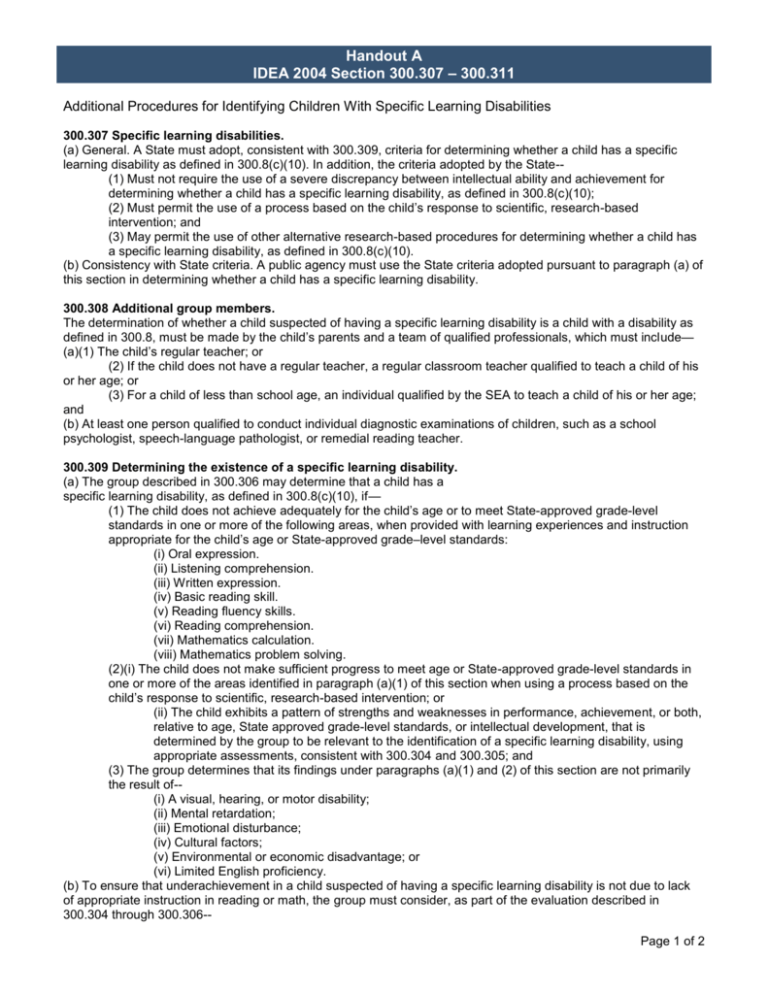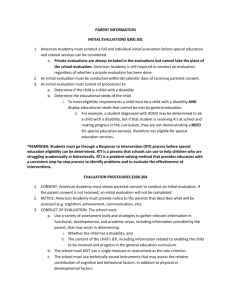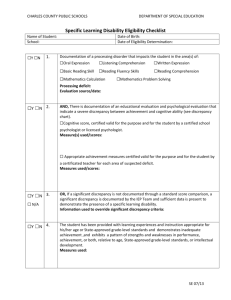SLD Handout A
advertisement

Handout A IDEA 2004 Section 300.307 – 300.311 Additional Procedures for Identifying Children With Specific Learning Disabilities 300.307 Specific learning disabilities. (a) General. A State must adopt, consistent with 300.309, criteria for determining whether a child has a specific learning disability as defined in 300.8(c)(10). In addition, the criteria adopted by the State-(1) Must not require the use of a severe discrepancy between intellectual ability and achievement for determining whether a child has a specific learning disability, as defined in 300.8(c)(10); (2) Must permit the use of a process based on the child’s response to scientific, research-based intervention; and (3) May permit the use of other alternative research-based procedures for determining whether a child has a specific learning disability, as defined in 300.8(c)(10). (b) Consistency with State criteria. A public agency must use the State criteria adopted pursuant to paragraph (a) of this section in determining whether a child has a specific learning disability. 300.308 Additional group members. The determination of whether a child suspected of having a specific learning disability is a child with a disability as defined in 300.8, must be made by the child’s parents and a team of qualified professionals, which must include— (a)(1) The child’s regular teacher; or (2) If the child does not have a regular teacher, a regular classroom teacher qualified to teach a child of his or her age; or (3) For a child of less than school age, an individual qualified by the SEA to teach a child of his or her age; and (b) At least one person qualified to conduct individual diagnostic examinations of children, such as a school psychologist, speech-language pathologist, or remedial reading teacher. 300.309 Determining the existence of a specific learning disability. (a) The group described in 300.306 may determine that a child has a specific learning disability, as defined in 300.8(c)(10), if— (1) The child does not achieve adequately for the child’s age or to meet State-approved grade-level standards in one or more of the following areas, when provided with learning experiences and instruction appropriate for the child’s age or State-approved grade–level standards: (i) Oral expression. (ii) Listening comprehension. (iii) Written expression. (iv) Basic reading skill. (v) Reading fluency skills. (vi) Reading comprehension. (vii) Mathematics calculation. (viii) Mathematics problem solving. (2)(i) The child does not make sufficient progress to meet age or State-approved grade-level standards in one or more of the areas identified in paragraph (a)(1) of this section when using a process based on the child’s response to scientific, research-based intervention; or (ii) The child exhibits a pattern of strengths and weaknesses in performance, achievement, or both, relative to age, State approved grade-level standards, or intellectual development, that is determined by the group to be relevant to the identification of a specific learning disability, using appropriate assessments, consistent with 300.304 and 300.305; and (3) The group determines that its findings under paragraphs (a)(1) and (2) of this section are not primarily the result of-(i) A visual, hearing, or motor disability; (ii) Mental retardation; (iii) Emotional disturbance; (iv) Cultural factors; (v) Environmental or economic disadvantage; or (vi) Limited English proficiency. (b) To ensure that underachievement in a child suspected of having a specific learning disability is not due to lack of appropriate instruction in reading or math, the group must consider, as part of the evaluation described in 300.304 through 300.306-Page 1 of 2 (1) Data that demonstrate that prior to, or as a part of, the referral process, the child was provided appropriate instruction in regular education settings, delivered by qualified personnel; and (2) Data-based documentation of repeated assessments of achievement at reasonable intervals, reflecting formal assessment of student progress during instruction, which was provided to the child’s parents. (c) The public agency must promptly request parental consent to evaluate the child to determine if the child needs special education and related services, and must adhere to the timeframes described in 300.301 and 300.303, unless extended by mutual written agreement of the child’s parents and a group of qualified professionals, as described in 300.306(a)(1)-(1) If, prior to a referral, a child has not made adequate progress after an appropriate period of time when provided instruction, as described in paragraphs (b)(1) and (b)(2) of this section; and (2) Whenever a child is referred for an evaluation. 300.310 Observation. (a) The public agency must ensure that the child is observed in the child’s learning environment (including the regular classroom setting) to document the child’s academic performance and behavior in the areas of difficulty. (b) The group described in 300.306(a)(1), in determining whether a child has a specific learning disability, must decide to-(1) Use information from an observation in routine classroom instruction and monitoring of the child’s performance that was done before the child was referred for an evaluation; or (2) Have at least one member of the group described in 300.306(a)(1) conduct an observation of the child’s academic performance in the regular classroom after the child has been referred for an evaluation and parental consent, consistent with 300.300(a), is obtained. (c) In the case of a child of less than school age or out of school, a group member must observe the child in an environment appropriate for a child of that age. 300.311 Specific documentation for the eligibility determination. (a) For a child suspected of having a specific learning disability, the documentation of the determination of eligibility, as required in 300.306(a)(2), must contain a statement of-(1) Whether the child has a specific learning disability; (2) The basis for making the determination, including an assurance that the determination has been made in accordance with 300.306(c)(1); (3) The relevant behavior, if any, noted during the observation of the child and the relationship of that behavior to the child’s academic functioning; (4) The educationally relevant medical findings, if any; (5) Whether-(i) The child does not achieve adequately for the child’s age or to meet State-approved grade-level standards consistent with 300.309(a)(1); and (ii)(A) The child does not make sufficient progress to meet age or State-approved grade-level standards consistent with 300.309(a)(2)(i); or (B) The child exhibits a pattern of strengths and weaknesses in performance, achievement, or both, relative to age, State-approved grade level standards or intellectual development consistent with 300.309(a)(2)(ii); (6) The determination of the group concerning the effects of a visual, hearing, or motor disability; mental retardation; emotional disturbance; cultural factors; environmental or economic disadvantage; or limited English proficiency on the child’s achievement level; and (7) If the child has participated in a process that assesses the child’s response to scientific, research-based intervention-– (i) The instructional strategies used and the student-centered data collected; and (ii) The documentation that the child’s parents were notified about-(A) The State’s policies regarding the amount and nature of student performance data that would be collected and the general education services that would be provided; (B) Strategies for increasing the child’s rate of learning; and (C) The parents’ right to request an evaluation. (b) Each group member must certify in writing whether the report reflects the member’s conclusion. If it does not reflect the member’s conclusion, them group member must submit a separate statement presenting the member’s conclusions. Page 2 of 2





